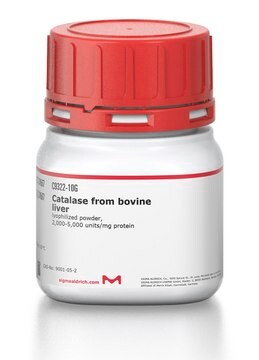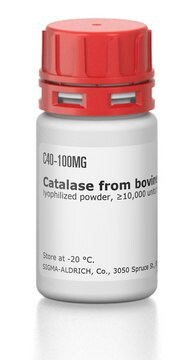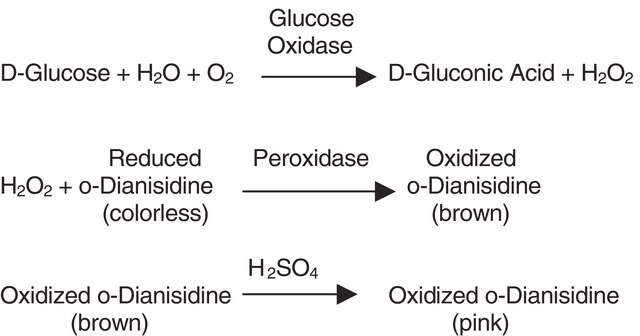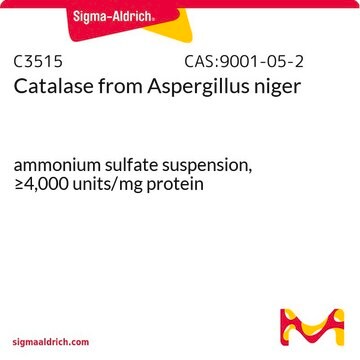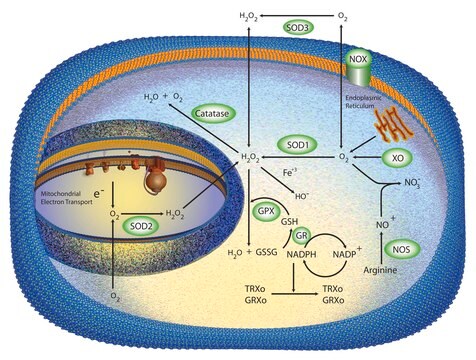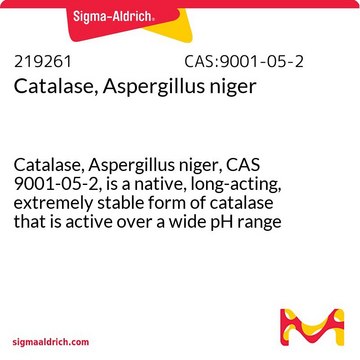C1345
Catalase from bovine liver
powder, suitable for cell culture, 2,000-5,000 units/mg protein
Synonym(s):
H2O2:H2O2 oxidoreductase
Sign Into View Organizational & Contract Pricing
All Photos(3)
About This Item
Recommended Products
biological source
bovine liver
Quality Level
product line
BioReagent
form
powder
specific activity
2,000-5,000 units/mg protein
mol wt
tetramer ~250 kDa
technique(s)
cell culture | mammalian: suitable
isoelectric point
5.4
UniProt accession no.
shipped in
wet ice
storage temp.
−20°C
SMILES string
O(CC)C(=O)c1ccc(cc1)O
InChI
1S/C9H10O3/c1-2-12-9(11)7-3-5-8(10)6-4-7/h3-6,10H,2H2,1H3
InChI key
NUVBSKCKDOMJSU-UHFFFAOYSA-N
Gene Information
cow ... CAT(280743)
Looking for similar products? Visit Product Comparison Guide
General description
CAT (catalase) is an endogenous antioxidant enzyme, thus conferring protection to cells against damage by ROS (reactive oxygen species). In humans, this gene is localized to chromosome 11p13, which is composed of 12 introns and 13 exons.
Research Area: Cell Signaling
Catalase from bovine liver is a tetramer consisting of 4 equal subunits each with a 60 kDa molecular weight. Each of these subunits contains iron bound to a protoheme IX group. The enzyme will also strongly bind to NADP, where NADP and the heme group are within 13.7 angstroms.
Catalase from bovine liver is a tetramer consisting of 4 equal subunits each with a 60 kDa molecular weight. Each of these subunits contains iron bound to a protoheme IX group. The enzyme will also strongly bind to NADP, where NADP and the heme group are within 13.7 angstroms.
Application
Catalase acts as a natural antioxidant to study the roles of reactive oxygen species in gene expression and apoptosis. It has also been used to protect against oxidative damage to proteins, lipids, and nucleic acids. Industrially, catalzes have been used to remove hydrogen peroxide added to milk and cheese, in textile bleaching, and to examine its positive effects on the viability of DNA-repair mutants of E. coli.
Catalase from bovine liver may be used:
Catalase from bovine liver may be used:
- to prepare H2O2-O2 based biocathode for applications in glucose biofuel cells
- to study the kinetic properties and storage stability of catalase immobilized on to florisil
- in glutathione-mediated superoxide generation in an aqueous solution
Catalase from bovine liver is used for the following applications:
- Gel filtration
- Analytical filtration on Ultrogel and glycerol gradient centrifugation
- Size exclusion chromatography (HPLC)-HPLC analysis of estrogen receptor
- Enzyme assays
- Alcohol oxidase activity
Biochem/physiol Actions
Catalase, an antioxidant enzyme found in all aerobic organisms, catalyzes the degradation of hydrogen peroxide, a byproduct of metabolic processes, into less harmful water and oxygen. It can also react with alkylhydrogen peroxides, such as methylperoxide and ethylperoxide and the second H2O2 molecule can be replaced by methanol, ethanol, propanol, formate and nitrate as a hydrogen donor. Catalase enzyme uses either iron (Fe) or manganese (Mn) as cofactor, and are classified as Fe-CAT or Mn-CAT.
This product doesn not need any activators, but it is inhibited by 3-amino-1-H-1,2,4 triazole, cyanide, azide, hydroxylamine, cyanogens bromide, 2-mercaptoethanol, dithiothreitol, dianisidnie and nitrate.
Caution
Solutions of catalse should not be frozen. Frozen solution will result in a 50-70% loss of activity.
Unit Definition
One unit will decompose 1.0 μmole of H2O2 per min at pH 7.0 at 25 °C, while the H2O2 conc. falls from 10.3 to 9.2 mM, measured by the rate of decrease of A240.
Preparation Note
This product is a powder suitable for cell culture with activity at 2,000-5,000 units/mg. The enzyme is soluble in 50 mM potassium phosphate buffer at 1 mg/mL and pH 7.0.
inhibitor
Product No.
Description
Pricing
Signal Word
Danger
Hazard Statements
Precautionary Statements
Hazard Classifications
Resp. Sens. 1
Storage Class Code
11 - Combustible Solids
WGK
WGK 1
Flash Point(F)
Not applicable
Flash Point(C)
Not applicable
Personal Protective Equipment
dust mask type N95 (US), Eyeshields, Gloves
Choose from one of the most recent versions:
Already Own This Product?
Find documentation for the products that you have recently purchased in the Document Library.
Customers Also Viewed
G Redeuilh et al.
The Journal of biological chemistry, 262(15), 6969-6975 (1987-05-25)
The structure of the calf uterus nontransformed molybdate-stabilized estradiol receptor (ER) has been investigated using affinity labeling with tamoxifen aziridine and several monoclonal antibodies directed either against the steroid binding protein (Mr approximately 65,000) or against the heat shock protein
Theppanya Charoenrat et al.
Bioprocess and biosystems engineering, 27(6), 399-406 (2005-08-05)
An oxygen-limited fed-batch technique (OLFB) was compared to traditional methanol-limited fed-batch technique (MLFB) for the production of recombinant Thai Rosewood beta-glucosidase with Pichia pastoris. The degree of energy limitation, expressed as the relative rate of respiration (q(O)/q(O,max)), was kept similar
Taku Amo et al.
Journal of bacteriology, 184(12), 3305-3312 (2002-05-25)
We had previously isolated a facultatively anaerobic hyperthermophilic archaeon, Pyrobaculum calidifontis strain VA1. Here, we found that strain VA1, when grown under aerobic conditions, harbors high catalase activity. The catalase was purified 91-fold from crude extracts and displayed a specific
J M Renoir et al.
European journal of biochemistry, 127(1), 71-79 (1982-09-01)
A molydate-stabilized, 'non-activated' form of the progesterone receptor from the cytosol of oestrogen-stimulated chick oviduct has been purified to homogeneity by a three-step procedure. The first step, affinity chromatography using a N-(12-amino-dodecyl)-3-oxo-4-androsten-17 beta-carboxamide-substituted Sepharose gel, purified the receptor 1500-2700-fold with
Yanqiong Liu et al.
Medicine, 94(13), e702-e702 (2015-04-04)
Reactive oxygen species (ROS) play critical roles in hepatocarcinogenesis. The catalase (CAT) enzyme is involved in the repair of ROS. Therefore, we investigate the association between CAT gene polymorphisms and the risk of hepatocellular carcinoma (HCC). A total of 715
Our team of scientists has experience in all areas of research including Life Science, Material Science, Chemical Synthesis, Chromatography, Analytical and many others.
Contact Technical Service